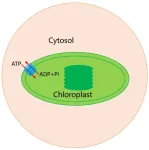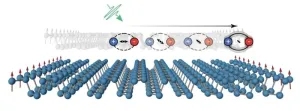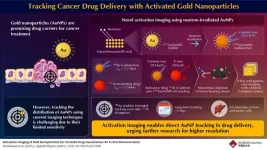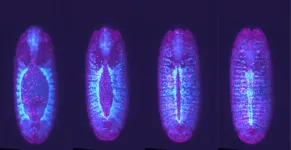(Press-News.org)
Modern communication networks rely on optical signals to transfer vast amounts of data. But just like a weak radio signal, these optical signals need to be amplified to travel long distances without losing information. The most common amplifiers, erbium-doped fiber amplifiers (EDFAs), have served this purpose for decades, enabling longer transmission distances without the need for frequent signal regeneration. However, they operate within a limited spectral bandwidth, restricting the expansion of optical networks.
To meet the growing demand for high-speed data transmission, researchers have been seeking ways to develop more powerful, flexible, and compact amplifiers. Even though AI accelerators, data centers, and high-performance computing systems handle ever-increasing amounts of data, the limitations of existing optical amplifiers are becoming more evident.
The need for ultra-broadband amplification — amplifiers that work across a wider range of wavelengths — is more pressing than ever. Existing solutions, such as Raman amplifiers, offer some improvement, but they are still too complex and energy hungry.
Now, researchers led by Tobias Kippenberg at EPFL and Paul Seidler at IBM Research Europe – Zurich have developed a photonic-chip-based traveling-wave parametric amplifier (TWPA) that achieves ultra-broadband signal amplification in an unprecedentedly compact form. Using gallium phosphide-on-silicon dioxide technology, the new amplifier attains a net gain of over 10 dB across a bandwidth of approximately 140 nm — three times wider than a conventional C-band EDFA.
Most amplifiers rely on rare-earth elements to strengthen signals. Instead, the new amplifier uses optical nonlinearity — a property where light interacts with a material to amplify itself. By carefully designing a tiny spiral waveguide, the researchers created a space where light waves reinforce each other, boosting weak signals while keeping noise low. This method not only makes the amplifier more efficient but also allows it to work across a much broader range of wavelengths, all within a compact, chip-sized device.
The team chose gallium phosphide because of its exceptional optical properties. First, it exhibits strong optical nonlinearity, which means that light waves passing through it can interact in a way that boosts signal strength. Second, it has a high refractive index, which allows light to be confined tightly within the waveguide, leading to more efficient amplification. By using gallium phosphide, the scientists achieved high gain with a waveguide only a few centimeters long , significantly reducing the amplifier’s footprint and making it practical for next-generation optical communication systems.
The researchers demonstrated that their chip-based amplifier could achieve up to 35 dB of gain while keeping the noise low. Additionally, remarkably weak signals could be amplified, with the amplifier handling input powers ranging over six orders of magnitude. These features make the new amplifier highly adaptable to a variety of applications beyond telecommunications, such as precision sensing
The amplifier also enhanced the performance of optical frequency combs and coherent communication signals — two key technologies in modern optical networks and photonics — showing that such photonic integrated circuits can surpass traditional fiber-based amplification systems.
The new amplifier has far-reaching implications for the future of data centers, AI processors, and high-performance computing systems, all of which can benefit from faster, more efficient data transfer. And the applications extend beyond data transmission, to optical sensing, metrology, and even LiDAR systems used in self-driving vehicles.
Other contributors
EPFL Center of Quantum Science and Engineering
IBM Research Europe – Zurich
Reference
Kuznetsov, N., Nardi, A., Riemensberger, J., Davydova, A., Churaev, M., Seidler, P., Kippenberg, T. J. An ultra-broadband photonic-chip-based traveling-wave parametric amplifier. Nature 12 March 2025. DOI: 10.1038/s41586-025-08666-z
END
A recent study by Chinese scientists has revealed the intricate molecular machinery driving energy exchange within chloroplasts, shedding light on a key event in the evolution of plant life. Led by FAN Minrui from the Center for Excellence in Molecular Plant Sciences of the Chinese Academy of Sciences, the research elucidates the structure and function of the ATP/ADP translocator—a crucial member of the nucleotide transporter (NTT) family of proteins—which facilitates the transfer of energy across chloroplast membranes.
Their findings were published online in ...
Scientists have long suspected that phosphorene nanoribbons (PNRs) – thin pieces of black phosphorus, only a few nanometres wide – might exhibit unique magnetic and semiconducting properties, but proving this has been difficult. In a recent study published in Nature, researchers focused on exploring the potential for magnetic and semiconducting characteristics of these nanoribbons. Using techniques such as ultrafast magneto-optical spectroscopy and electron paramagnetic resonance they were able to demonstrate the magnetic behaviour of PNRs at room temperature, and show how these magnetic properties can interact with light.
The ...
HOUSTON ― The University of Texas MD Anderson Cancer Center’s Research Highlights showcases the latest breakthroughs in cancer care, research and prevention. These advances are made possible through seamless collaboration between MD Anderson’s world-leading clinicians and scientists, bringing discoveries from the lab to the clinic and back.
Study offers insights into evolutionary process driving pancreatic cancer
Read summary | Read study in Nature
Pancreatic cancer is hard to treat because ...
Gold nanoparticles (AuNPs) are tiny gold particles of 1–100 nanometers and have unique chemical and biological properties. Due to their potential to accumulate in tumors, these nanoparticles have emerged as promising drug carriers for cancer therapy and targeted drug delivery. However, tracking the movement of these nanoparticles in the body has been a major challenge. Traditional imaging methods often involve tracers like fluorescent dyes and radioisotopes, which give limited visualization and inaccurate results due to detachment from AuNPs.
In a step to advance the imaging of AuNPs, researchers from Waseda ...
SAN ANTONIO — March 12, 2025 — Four small suitcase-sized spacecraft, designed and built by Southwest Research Institute headquartered in San Antonio, launched from Vandenberg Space Force Base in California on March 11. NASA’s Polarimeter to Unify the Corona and Heliosphere, or PUNCH, constellation has spread out in a low-Earth orbit along the day-night line, providing a clear view in all directions for its two-year primary mission.
“The PUNCH spacecraft are now drifting into perfect position to study the solar corona, the Sun’s outer ...
In developing hearts, cells shuffle around, bumping into each other to find their place, and the stakes are high: pairing with the wrong cell could mean the difference between a beating heart and one that falters. A study publishing on March 12 in the Cell Press journal Biophysical Journal demonstrates how heart cells go about this “matchmaking” process. The researchers model the intricate movements of these cells and predict how genetic variations could disrupt the heart development process in fruit flies.
In both humans and fruit flies, the heart’s tissues arise from two distinct regions of ...
Study compares those with food insecurity to food-secure individuals over 20 years
Food insecurity is associated with a 41% increased risk of heart disease over time
Findings suggest food security screening as a key tool to prevent heart disease
CHICAGO --- Struggling to afford food today could mean heart problems tomorrow. Young adults experiencing food insecurity have a 41% greater risk of developing heart disease in midlife, even after accounting for demographic and socioeconomic factors, according to a new Northwestern Medicine study. Food insecurity — struggling to get enough nutritious ...
About The Study: In this prospective cohort study among participants in the Coronary Artery Risk Development in Young Adults (CARDIA) study, food insecurity was associated with incident cardiovascular disease (CVD) even after adjustment for socioeconomic factors, suggesting that food insecurity may be an important social deprivation measure in clinical assessment of CVD risk. Whether interventions to reduce food insecurity programs can potentially alleviate CVD should be further studied.
Corresponding Author: To contact the corresponding author, Jenny Jia, MD, MSc, email jenny.jia@northwestern.edu.
To access the embargoed study: ...
About The Study: This cohort study found that healthier diets and lower waist to hip ratio throughout midlife were associated with better brain and cognitive health in older age. The findings suggest that interventions to improve diet and manage central obesity might be most effective between ages 48 and 70.
Corresponding Author: To contact the corresponding author, Daria E. A. Jensen, DPhil, email jensen@cbs.mpg.de.
To access the embargoed study: Visit our For The Media website at this link https://media.jamanetwork.com/
(doi:10.1001/jamanetworkopen.2025.0171)
Editor’s Note: Please see the article for additional information, ...
Background and objectives
Gastrointestinal endoscopy has revolutionized the entire practice of gastroenterology worldwide, including Nigeria. Endoscopy was introduced in Nigeria more than four decades ago, and it has been a story of varying successes and challenges. This study explored the various experiences of endoscopists, the challenges they face, and the efforts put in place to maintain the practice in Nigeria.
Methods
This cross-sectional survey was conducted from October to December 2023 among endoscopists practicing ...







